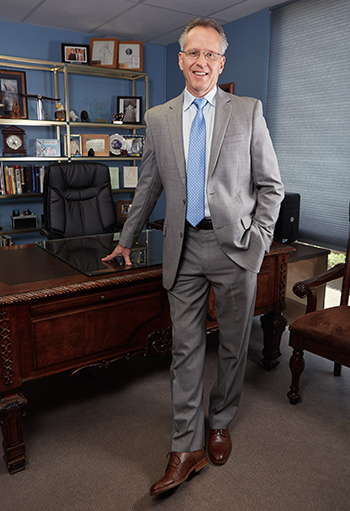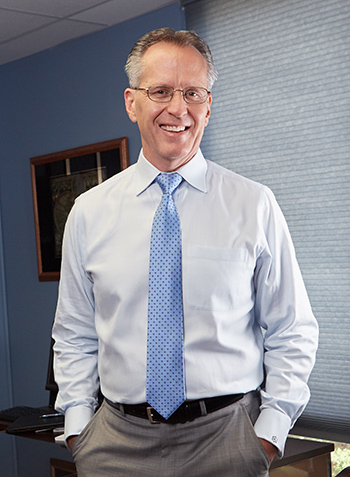Helping clients achieve three key principles for retirement success
Helping clients achieve three key principles for retirement success

Douglas Bauerband • Toms River, NJ
G. Douglas Financial Group • TFS Securities, Inc.
Read full biography below
Proactive Advisor Magazine: Doug, talk about how you entered the business and your philosophy concerning client relationships.
I was brought up in a solid, supportive, Christian family environment. We placed a high value on doing the right thing with your life and in how you treat others. I entered the financial-services business at an early age because of my father’s encouragement and will be forever thankful for that. He and I worked in adjoining office spaces for 18 years. My specialty was in property and casualty insurance, and his was in investments.
As he was winding down his career, my father convinced me that the greatest future opportunity was going to be found in the investment and advisory space. I agreed and worked hard over the next few years to become knowledgeable in the investment area. In addition to my licensing studies, I attended every professional presentation I could and sought the advice of other advisors. One very experienced advisor took a strong interest in my career and basically became my second mentor. He had a solid background in portfolio construction and the strengths and weaknesses of various investment products. He also guided me in the development of a financial seminar program that was integral to building my business in the early years.
My father and my second mentor shared a service philosophy that centered on doing the best you can to help clients with their specific needs, not selling prepackaged solutions. I operate under the same philosophy. The rewards I work for are lives well-lived, people enjoying peace of mind and financial freedom, and for clients to leave an impactful legacy for heirs, charities, or their church. If our firm can help clients advance toward those goals, we will consider ourselves successful.
What planning process do you use to help achieve those objectives?
 I think the early stages of our process are a little different from those of most advisors. First, I strongly encourage all prospective clients or client couples to attend one of our financial-planning seminars. This allows them to sit back and hear about our firm’s credentials and our approach to financial and investment planning without feeling any pressure. In effect, I am allowing them to interview me by hearing my overview of the many issues that may affect their financial lives.
I think the early stages of our process are a little different from those of most advisors. First, I strongly encourage all prospective clients or client couples to attend one of our financial-planning seminars. This allows them to sit back and hear about our firm’s credentials and our approach to financial and investment planning without feeling any pressure. In effect, I am allowing them to interview me by hearing my overview of the many issues that may affect their financial lives.
Once they have attended the seminar, I send them what I call a “pre-fit letter.” The pre-fit letter outlines what we’re looking for in a client and what the client might be looking for in an advisor. When we have our initial meeting, we should hopefully have some common expectations established. But I tell prospective clients that we should both be interviewing each other, since relating well will be a very important factor in establishing a long-term and productive relationship.
Assuming that all goes well, and it usually does, we will get into an introductory and lengthy conversation. It is very important that both spouses be there. During this conversation, I review the three cornerstones of what we would like to help them achieve: peace of mind, freedom, and impact for their legacy. I like to have an interactive session using a whiteboard. We dig into their concerns in all three of those areas. What keeps them up at night? Where do they feel they are doing well financially? What have their experiences been in the past with money and investing? What are the unique circumstances of their professional and personal lives?
On the board, we will rank their major financial concerns, and I will outline some big-picture planning thoughts. I like to ask clients to then imagine themselves in a Norman Rockwell painting. What is the image they would like to see for themselves in the future? How should that picture turn out? This is a projection exercise trying to get them to imagine their ideal lifestyle going forward. We can’t always promise they will get there, but it is a goal to shoot for and says a lot about their dreams and aspirations.
The rest of the process gets down into the details of their current financial affairs, identifying liabilities, assets, and potential income streams moving forward. Our team then works through financial-planning options. We have two excellent software programs that help us formulate the plan. For some planning cases, I may consult with outside specialists or investment firms we work with, or I may use resources at our broker-dealer. After we present a plan to the client, we want to make sure we educate them as much as possible on the thinking and rationale behind our recommendations. Execution of the plan, tracking progress versus objectives, and having regular follow-up review sessions are critical next steps in the process.
How do you approach money management for clients?
 That obviously depends on each client’s financial plan, overall objectives, risk profile, and time horizon. If risk assets have a place in a client’s plan, we work with several different investment managers who have different styles of money management. We will select the manager who is right for a specific client, or we may use more than one manager for a client.
That obviously depends on each client’s financial plan, overall objectives, risk profile, and time horizon. If risk assets have a place in a client’s plan, we work with several different investment managers who have different styles of money management. We will select the manager who is right for a specific client, or we may use more than one manager for a client.
The first management style is active, tactical portfolio management. The objective here is to try to achieve competitive returns when markets are trending higher while also closely managing the portfolio, making portfolio adjustments when market conditions call for it. These are quantitative, algorithm-based strategies that place an emphasis on risk management. When conditions in the market start to deteriorate, many of these strategies can move allocations to 100% cash and might also use inverse funds when the trend is clearly to the downside.
The emphasis on risk management means these portfolio managers seek to mitigate the worst of market losses, such as those seen in the credit crisis. When markets start to improve after a bear market, client portfolios can be reallocated to risk assets, starting over again on a growth curve. That way, client portfolios should spend less time making up for losses and more time building wealth.
The second approach is more geared to income and is closer to a true buy-and-hold strategy. This investment manager selects blue-chip, quality companies that pay competitive dividends. Over a longer time frame, we have a relatively high level of confidence that these company stocks will rebound from any declines in price that accompany a broad market downturn. Clients will need to understand from the start that the price of these stocks will go through up and down cycles. But, if they are willing to hold on through those cycles, they should see long-term price appreciation plus a steady stream of dividends.
“The rewards I work for are lives well-lived, people enjoying peace of mind and financial freedom, and for clients to leave an impactful legacy…”
The third manager we use is appropriate for clients with the most aggressive risk profiles. These clients are primarily concerned with growth. The benefit of this manager’s style is that it combines an aggressive growth portfolio with some hedging techniques. The client may still see some significant drawdowns during bear markets, but they should be less than that of overall market indexes.
The bottom line is that we can customize a portfolio approach for each of our clients. The key is making sure clients have a full understanding of the parameters of the types of strategies that we jointly agree on for their portfolio. My personal investment philosophy as I approach client portfolios is that most people take on too much risk for the returns they seek. I think our managers help us greatly in developing portfolio solutions that can keep that risk-return equation in the proper balance.
As clients work with your firm over a period of some years, what would you like them to say about that experience?
Many of our new clients do come in via referrals, and I am confident that the vast majority of our current clients would portray their experience in a very positive light. It goes back to the three core concepts I spoke about before: peace of mind, freedom, and impact. We cannot guarantee any level of investment returns. But we will guarantee that clients will receive the resources, knowledge, and continued effort to try to help them reach their important personal and financial goals. Our efforts will be delivered with integrity and respect for the individual client’s principles. At the end of the day, I want clients to feel they have received real value from our relationship. That is at the center of everything our firm does, and I believe we deliver that value in many tangible ways.

Finding the right fit with a business coach
Doug Bauerband believes a good business coach can add transformational value to an advisory business. Here are his quick tips on finding and working with one:
- Conduct exhaustive due diligence on potential coaches. Your practice and clients deserve it.
- Make sure your prospective coach is philosophically aligned with your belief system as an advisor.
- Understand fully what services you will receive and how they will be delivered.
- Design a meaningful and distinctive client value proposition with your coach’s guidance. It can pay huge dividends for your practice.
 Douglas Bauerband is the founder and president of G. Douglas Financial Group, an independent wealth-planning firm. He has owned his investment firm, which is located in Ocean County, New Jersey, for 20 years and has 35 years of experience in investment and insurance consulting.
Douglas Bauerband is the founder and president of G. Douglas Financial Group, an independent wealth-planning firm. He has owned his investment firm, which is located in Ocean County, New Jersey, for 20 years and has 35 years of experience in investment and insurance consulting.
Mr. Bauerband says his practice “helps business owners, executives, and professionals avoid common retirement mistakes and more fully enjoy a secure retirement.” He has earned national recognition as a financial educator, author, speaker, and retirement planner. Mr. Bauerband frequently holds seminars on retirement planning and is the co-author of a soon-to-be-published book, “Retire Abundantly.” He says the book is part of his mission “to educate more people about creating a fulfilling retirement lifestyle and legacy.”
Before beginning his career in the securities industry, Mr. Bauerband attended insurance and real estate schools in New Jersey. He was an independent property and casualty broker for 18 years. During that time, Mr. Bauerband says he recognized that individuals, as well as businesses, needed a professional financial advisor. He began offering financial services with US Life and founded his firm a year later.
Mr. Bauerband is married and has four children. He and his family attend Living Faith Bible Church in Brick, New Jersey. Mr. Bauerband has presented charitable-giving and financial seminars at Christian retreat centers, including Word of Life and Americas Keswick. He is on the board of trustees for three nonprofit organizations. An Eagle Scout in high school, Mr. Bauerband enjoys the outdoors and several sports.
Disclosure: Securities offered through TFS Securities, Inc., member FINRA/SIPC, a full-service broker-dealer located at 437 Newman Springs Road, Lincroft, New Jersey, 07738, (732) 758-9300. Investment advisor services offered through TFS Advisory Services, a division of TFS. G. Douglas Financial Group is not affiliated with TFS Securities, Inc., or registered as a broker-dealer.
Photography by Deirdre Ryan

